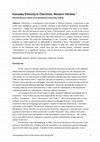Papers by Karolina Koziura
The Burden of the Past: History, Memory and Identity in Contemporary Ukraine edited by Anna Wylegala and Magdalena Glowacka. Bloomington: Indiana University Press, 2019

East European Politics and Societies: and Culture 33.1, 2019
This article explores ways in which Habsburg nostalgia has become an important factor in contempo... more This article explores ways in which Habsburg nostalgia has become an important factor in contemporary place-making strategies in the city of Chernivtsi, Western Ukraine. Through the analysis of diasporic homecomings, city center revitalization, and nationalist rhetoric surrounding the politics of monuments, I explore hybrid and diverse ways in which Habsburg nostalgia operates in a given setting. Rather than a static and homogenous form of place attachment, in Chernivtsi different cultural practices associated with Habsburg nostalgia coexist with each other and depending on the political context as well as the social position of the “nostalgic agents” manifest themselves differently. Drawing from my long-term ethnographic fieldwork, I argue that in order to fully understand individuals’ attachment to space, it is necessary to grasp both the subtle emotional ways in which the city is experienced by individuals as well as problematize the role of the built environment in the visualization of collective memory and emotions of particular groups. The focus on changing manifestations of the Habsburg nostalgia can bring then a better understanding of the range and scope of the city’s symbolic resources that might be mobilized for various purposes.
Diversity and Local Contexts: Urban Space, Borders and Migration ed. Jerome Krase and Zdenek Uherek, 2017

Ukraina Moderna , 2016
Починаючи з 1990-их рр. у постсоціалістичному регіоні почали виникати «маленькі Відні», «Рими» т... more Починаючи з 1990-их рр. у постсоціалістичному регіоні почали виникати «маленькі Відні», «Рими» та «Парижи». Коли йшлося про перемоделювання місцевої урбаністичної пам’яті та ідентичності, ні важливість, ні розмір міста не мали значення. У процесах урбаністичних трансформацій виявилися дві спільні тенденції. Перша пов’язана із усуненням радянських атрибутів, друга – з ностальгійним «пост-габсбурзькими» почуттями, що супроводжували процес відновлення. Сучасні Чернівці, подібно до інших міст Західної України, можна розглядати як калейдоскоп, в якому історія і пам'ять є визначальними факторами у моделюванні міського простору. Міф «маленького Відня на Сході» є не лише частиною основної стратегії створення нової міської ідентичності Чернівців пострадянського періоду, він також є центральним у різних стратегіях націоналізації. У культурологічному сенсі Буковина і Чернівці займають важливе символічне місце, охоплюючи національні міфи видатних українців, румунів та євреїв, історія яких пов’язана з містом. Відтак, «маленький Відень на Сході» може сприйматися як інклюзивний міф, який пропагує міську різноманітність та європейську культуру, але він також може бути зманіпульований та використаний у націоналістичних стратегіях, які демонструють вищість та унікальність цієї групи.
Теоретично та методологічно ця стаття базується на етнографічному практичному дослідженні міських трансформацій пострадянських Чернівців, яке проводилося з 2010 до 2015 року. Через аналіз зв’язків між історією, пам’яттю та ідентичністю у міському просторі це дослідження поміщає сучасні Чернівці у контекст (пост)колоніальної реконцептуалізації Центральної та Східної Європи.

“Sprawy Narodowościowe / Nationalities Affairs” 44/2014
Ukraine, as one of the states which became independent in 1991, can be perceived as an example of... more Ukraine, as one of the states which became independent in 1991, can be perceived as an example of the typical transition of Soviet Socialist Republics into democratic states centered on the issue of nationalizing policies and processes. However, there are also differences which make this country a very interesting case study for investigation. Mainly, Russians here form the biggest national group concentrated in the East and South of the country. The persistence and reuse of the “myth of two Ukraines” led to the widespread conclusion that Ukraine is a country which is divided between Ukrainophone West and Russophone East. This article is focuses on the third group, which is somehow hidden in the mainstream linguistic debates, namely the Russian-speaking citizens of Ukraine who define themselves as ethnic Ukrainians. Based on the examples of Donbas and Crimean regions, it tries to define whether one can perceive them as a national minority.
Regiony i regionalizmy w Europie, red. A.W.Brzezińska, J, Schmidt, 2014

Anthropology of East Europe Review vol 32, no 1, 2014
Chernivtsi, a contemporary town located in Western Ukraine, is perceived as one of the most multi... more Chernivtsi, a contemporary town located in Western Ukraine, is perceived as one of the most multiethnic places in Ukraine. Situated in the Ukrainian-Romanian borderlands, Chernivtsi’s ruling state and dominant national group has changed four times in its history. Since 1991, this city has been an arena for both a “Ukrainization” policy as well as the revival of national minority institutions. This article is based on ethnographic fieldwork conducted in Chernivtsi since 2010 and explores why and when ethnicity as a category of practice matters for ordinary people. By using the methodology of the “everyday” and taking “situational” ethnicity as a major approach, for individuals in Chernivtsi, I show “Ukrainianess” becomes an unmarked, obvious and taken for granted category in daily life. Thus, the nationalizing efforts of the Ukrainian state, which since the late socialist period constantly marked “Ukrainianess” as a significant category, can be perceived as successful and other national manifestations do not pose any threat to it.
Conference Presentations by Karolina Koziura
American Sociological Association (ASA), New York., 2019











Uploads
Papers by Karolina Koziura
Теоретично та методологічно ця стаття базується на етнографічному практичному дослідженні міських трансформацій пострадянських Чернівців, яке проводилося з 2010 до 2015 року. Через аналіз зв’язків між історією, пам’яттю та ідентичністю у міському просторі це дослідження поміщає сучасні Чернівці у контекст (пост)колоніальної реконцептуалізації Центральної та Східної Європи.
Conference Presentations by Karolina Koziura
Теоретично та методологічно ця стаття базується на етнографічному практичному дослідженні міських трансформацій пострадянських Чернівців, яке проводилося з 2010 до 2015 року. Через аналіз зв’язків між історією, пам’яттю та ідентичністю у міському просторі це дослідження поміщає сучасні Чернівці у контекст (пост)колоніальної реконцептуалізації Центральної та Східної Європи.